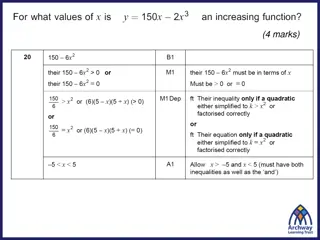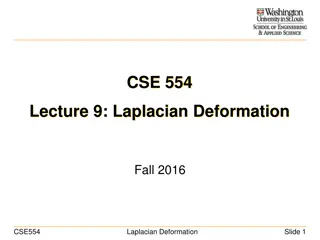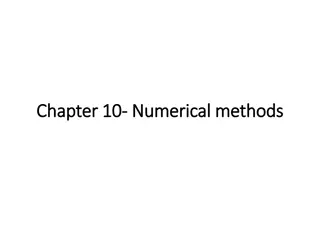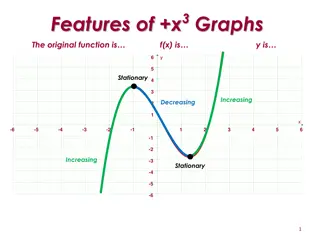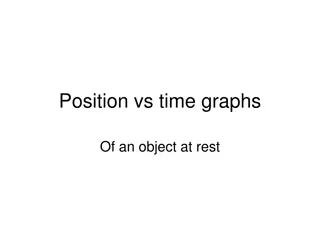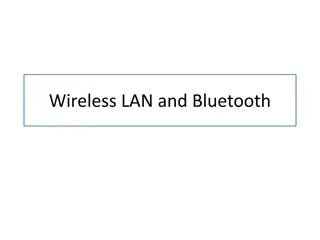
Stationary Points and Gradients in Calculus
Learn how to identify different types of stationary points in calculus by analyzing gradients. Discover the significance of maximum points, minimum points, and points of inflection in mathematical functions. Find out how differentiation helps determine the nature of stationary points, and how second derivatives indicate whether a point is a maximum or minimum.
Download Presentation

Please find below an Image/Link to download the presentation.
The content on the website is provided AS IS for your information and personal use only. It may not be sold, licensed, or shared on other websites without obtaining consent from the author. If you encounter any issues during the download, it is possible that the publisher has removed the file from their server.
You are allowed to download the files provided on this website for personal or commercial use, subject to the condition that they are used lawfully. All files are the property of their respective owners.
The content on the website is provided AS IS for your information and personal use only. It may not be sold, licensed, or shared on other websites without obtaining consent from the author.
E N D
Presentation Transcript
Teachings for Teachings for Exercise 12I Exercise 12I
Differentiation You can determine the nature of stationary points by considering gradients. y A point where f(x) stops increasing and starts decreasing is called a maximum point Local maximum A point where f(x) stops decreasing and starts increasing is called a minimum point x Point of inflexion A point of inflexion is where the gradient is locally a maximum or minimum (the gradient does not have to change from positive to negative, for example) Local minimum These are all known as turning points, and occur where f (x) = 0 12I
Differentiation You can determine the nature of stationary points by considering gradients. y To find the coordinates of these points, you need to: Local maximum 1) Differentiate f(x) to get the Gradient Function x Point of inflexion 2) Solve f (x) by setting it equal to 0 (as this represents the gradient being 0) Local minimum 3) Substitute the value(s) of x into the original equation to find the corresponding y-coordinate 12I
Differentiation The second derivative will tell us if the stationary point is a maximum or minimum y Notice how the diagram's gradient is always getting smaller x It starts very positive (and steep), gets less positive, equals 0, then becomes slightly negative, before becoming more negative The gradient's gradient is negative We describe this as ? ?? ?? < 0 ?? When ?2? ??2< 0 Or ?2? ??2< 0 we have a local maximum. 12I
Differentiation The second derivative will tell us if the stationary point is a maximum or minimum y Notice how the diagram's gradient is always getting bigger x It starts very negative (and steep), gets less negative, equals 0, then becomes slightly positive, before becoming more positive The gradient's gradient is positive We describe this as ? ?? ?? > 0 ?? When ?2? ??2> 0 Or ?2? ??2> 0 we have a local minimum. 12I
Differentiation All three points happen when ?? ??= 0 y ?2? ??2< 0 Local maximum x Point of inflexion ?2? ??2= 0 This does not mean that whenever ?2? Local minimum ??2= 0 ?2? ??2> 0 there is a point of inflexion, it could also be a local max or min, but every point of inflexion has ?2? If point of inflexion ?2? ??2= 0 ??2= 0. But A little more work is required here, but I will discuss this later If ?2? ??2= 0 Point of inflexion (it does suggest we should look into it though) 12I
Differentiation y Local maximum x Point of inflexion Local minimum ?? ??> 0 ?? ??< 0 ?? ??> 0 Apart from at point of inflexion where ?? ??= 0 12I
Differentiation Example Question You can determine the nature of stationary points by considering gradients. Find the coordinates of the turning point on the curve y = x4 32x, and state whether it is a minimum or maximum. To find the coordinates of these points, you need to: = 4 32 y x x Differentiate dy dx= 4 x 1) Differentiate f(x) to get the Gradient Function 3 4 32 x Set equal to 0 = 3 32 x = x = 0 2) Solve f (x) by setting it equal to 0 (as this represents the gradient being 0) Add 32 3 4 32 2 Divide by 4, then cube root 3) Substitute the value(s) of x into the original equation to find the corresponding y-coordinate = 4 4 32 y y = y = x (2) 48 x Sub 2 into the original equation Work out the y- coordinate 32(2) The stationary point is at (2, -48) 12I
Differentiation Example Question You can determine the nature of stationary points by considering gradients. Find the coordinates of the turning point on the curve y = x4 32x, and state whether it is a minimum or maximum. To find the coordinates of these points, you need to: = 4 32 y x x The stationary point is at (2, -48) dy dx= 1) Differentiate f(x) to get the Gradient Function 3 4 32 x Differentiate again 2 d y dx 2) Solve f (x) by setting it equal to 0 (as this represents the gradient being 0) = 2 12 x So the stationary point is a MINIMUM in this case! 2 2 12x 3) Substitute the value(s) of x into the original equation to find the corresponding y-coordinate Sub in the x coordinate 2 12(2) Positive = Minimum Negative = Maximum The rate of change of the rate of change is positive This means the rate of change (gradient) is about to increase! = 48 12I
Differentiation Example Question You can determine the nature of stationary points by considering gradients. Find the stationary points on the curve: y = 2x3 15x2 + 24x + 6, and state whether they are minima, maxima or points of inflexion To find the coordinates of these points, you need to: = + + 3 2 2 15 24 6 y x x x Differentiate + = 2 30x 24 '( ) x 6 f x 1) Differentiate f(x) to get the Gradient Function Set equal to 0 + = 2 6 30 24 0 x x Factorise 2) Solve f (x) by setting it equal to 0 (as this represents the gradient being 0) + = 2 6( 5 4) 0 x x Factorise again 4 = 6( x = 4)( OR 1) x = 0 x x Write the solutions 1 3) Substitute the value(s) of x into the original equation to find the corresponding y-coordinate Substituting into the original formula will give the following coordinates as stationary points: (1, 17) and (4, -10) 12I
Differentiation Stationary points at: (1, 17) and (4, -10) Example Question You can determine the nature of stationary points by considering gradients. Find the stationary points on the curve: y = 2x3 15x2 + 24x + 6, and state whether they are minima, maxima or points of inflexion To find the coordinates of these points, you need to: = + + 3 2 2 15 24 6 y x x x + = 2 30x 24 '( ) x 6 f x 1) Differentiate f(x) to get the Gradient Function Differentiate again = ''( ) 12 x 30 f x 2) Solve f (x) by setting it equal to 0 (as this represents the gradient being 0) Sub in x = 1 Sub in x = 4 = = ''( ) 12 x ''(1) 12(1) 30 = ''(1) 18 = 30 ''( ) 12 x ''(4) 12(4) 30 = ''(4) 18 = 30 f f f x f f f x 3) Substitute the value(s) of x into the original equation to find the corresponding y-coordinate So (1,17) is a Maximum So (4,-10) is a Minimum 12I
Differentiation You can determine the nature of stationary points by considering gradients. Please note that if ? ? = 0, the stationary point could be a minimum, maximum or a point of inflexion. In this case, find the gradient just before and just after the coordinate, this will then tell you the nature of the point. 12I



